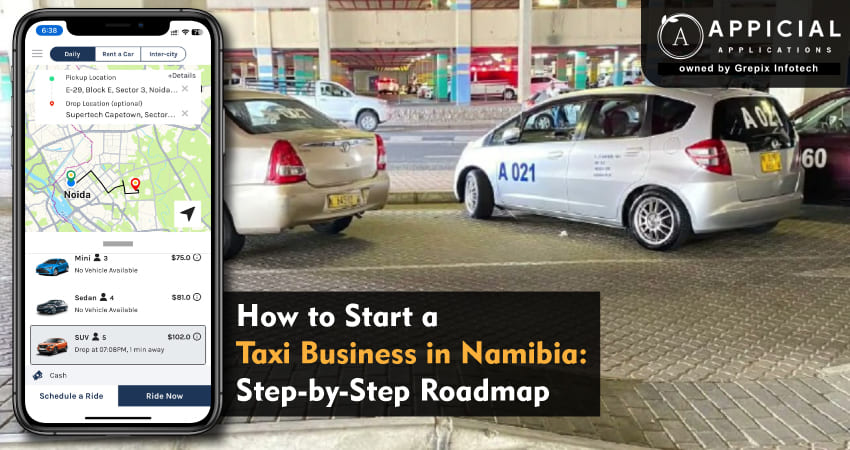
How to Start a Taxi Business in Namibia: Step-by-Step Roadmap
Namibia, known for its stunning landscapes and vibrant cities, is a country on the move. With urban areas expanding the demand for reliable transportation services is growing steadily. Starting a taxi business in Namibia not only addresses a critical need but also presents a profitable opportunity for aspiring entrepreneurs.
Starting a taxi business in Namibia is a promising venture for aspiring entrepreneurs. From understanding the industry to scaling your operations, every step requires careful planning and execution. By adhering to legal requirements, prioritizing customer satisfaction, and embracing innovation, you can build a successful taxi business that thrives in Namibia’s dynamic market.
If you're considering venturing into this dynamic industry, this comprehensive guide will walk you through every step of the journey.
Namibia, known for its breathtaking landscapes and thriving cities, presents a growing demand for transportation services driven by urbanization and a flourishing tourism sector. Starting a taxi business in Namibia offers a lucrative opportunity for entrepreneurs willing to navigate the challenges of competition, fuel costs, and regulatory requirements. Success lies in thorough market research, strategic planning, and adhering to legal standards. Key steps include acquiring permits, building a reliable fleet, and implementing customer-focused practices. Leveraging technology like taxi apps can streamline operations and enhance service quality. Entrepreneurs can thrive by prioritizing customer satisfaction and adaptability in Namibia’s dynamic market.
How to Start a Taxi Business in Namibia: Step-by-Step
1Understanding Namibia’s Taxi Industry
Current Trends and Opportunities
Namibia’s taxi industry is thriving due to urbanization and the growth of tourism. In cities like Windhoek and Swakopmund, locals and visitors rely heavily on taxis for daily commuting. This creates a steady demand for reliable taxi services, making it an opportune time to enter the market.
Common Challenges in the Taxi Sector
However, like any business, the taxi industry has its challenges. High competition, fluctuating fuel prices, and strict regulatory requirements can pose hurdles. However, with proper planning and execution, these challenges can be navigated successfully.
2 Research and Business Planning
Analyze the Market
The first step is understanding your target market. Who will you serve tourists, daily commuters, or both? Conduct thorough research to identify your potential customers' needs and analyze your competition to uncover gaps in the market.
Crafting a Business Plan
A well-thought-out business plan acts as a roadmap for your taxi business. Define your goals, set pricing strategies, and outline marketing tactics. A clear plan not only guides your business but also helps secure funding if needed.
3 Legal Requirements and Licensing
Registering Your Business
To operate legally, register your taxi business with the Ministry of Trade and Industry. This involves choosing a unique business name and acquiring a certificate of incorporation.
Acquiring Taxi Permits
Namibia’s Road Transportation Board oversees the issuance of taxi permits. These permits ensure that your vehicles are authorized to operate as public transport. Be prepared to provide all necessary documents and meet vehicle inspection standards.
Vehicle Insurance and Compliance
Insurance is crucial for protecting your business against unforeseen circumstances. Opt for comprehensive insurance that covers accidents, theft, and third-party liabilities. Additionally, ensure your vehicles meet Namibia’s road safety standards.
4 Procuring Vehicles
Choosing the Right Vehicles
The choice of vehicles can make or break your taxi business. Consider fuel efficiency, durability, and passenger capacity when selecting your fleet. Reliable brands that offer good resale value are often the best investment.
New vs. Used Vehicles
While new vehicles come with warranties and lower maintenance costs, used cars are more affordable upfront. Weigh the pros and cons based on your budget and long-term goals.
Financing Options
Whether you lease, finance, or buy vehicles outright, explore all options to find the best fit. Compare interest rates and terms to make an informed decision.
5 Building a Team
Hiring Drivers
Drivers are the backbone of your taxi business. Look for candidates with valid driver’s licenses, clean driving records, and excellent interpersonal skills.
Driver Training and Safety
Investing in driver training ensures they are prepared for challenges on the road. Teach them defensive driving techniques, customer service, and vehicle maintenance basics.
Retention Strategies
Happy drivers are loyal drivers. Offer competitive wages, incentives, and a supportive work environment to retain your team and keep them motivated.
6 Setting Up Operations
Fleet Management
Efficient fleet management is critical to the success of your taxi business. Use GPS tracking systems to monitor vehicle locations, optimize routes, and improve fuel efficiency. These systems also help ensure driver accountability and enhance customer safety.
Establishing Routes
Identifying high-demand areas and mapping efficient routes is essential. Focus on busy commercial zones, residential areas, and popular tourist destinations. This helps you maximize profits and minimize fuel costs. Adjust routes based on traffic patterns and peak hours for optimal operations.
Creating a Dispatch System
A robust dispatch system streamlines bookings and improves customer satisfaction. You can start with manual dispatching but consider upgrading to app-based systems as your business grows. These systems allow customers to book rides conveniently and help you manage operations seamlessly.
7 Marketing Your Taxi Business
Branding and Advertising
A strong brand identity sets your taxi business apart from competitors. Design a memorable logo and consistent color scheme for your vehicles. Advertise through flyers, posters, and radio spots to reach your target audience. Ensure your branding conveys professionalism and reliability.
Online Presence
In today’s digital age, having an online presence is non-negotiable. Create a user-friendly website that showcases your services, contact information, and booking options. Leverage social media platforms like Facebook and Instagram to engage with potential customers and promote special offers.
Word-of-Mouth Strategies
Word-of-mouth remains one of the most effective marketing strategies. Encourage satisfied customers to leave reviews online and recommend your services to others. Offer referral discounts to incentivize your loyal clients.
8 Managing Finances
Budgeting and Cash Flow
Maintain a detailed record of all expenses and income to track your business’s financial health. Budgeting helps you allocate funds efficiently for vehicle maintenance, driver salaries, and marketing efforts.
Pricing Strategies
Setting competitive fares is crucial. Research the market to understand the pricing standards and determine a fare structure that covers your costs while attracting customers. Offering promotions during slow periods can help boost ridership.
Also Read: Driving to Success: How to Become a Billionaire in Saudi Arabia's Taxi Business
Tax Compliance
Adhering to Namibia’s tax regulations is a legal obligation. Consult a tax professional to ensure you meet all requirements, including filing returns and paying VAT. Staying compliant avoids fines and legal issues.
9 Ensuring Customer Satisfaction
Maintaining Cleanliness and Safety
Customers appreciate clean and well-maintained vehicles. Regularly inspect and service your fleet to avoid breakdowns. Keep the interiors spotless and provide basic amenities like air conditioning for a comfortable ride.
Offering Exceptional Service
A smile and friendly conversation go a long way in creating a positive impression. Train your drivers to be courteous, punctual, and accommodating. Providing a reliable and pleasant experience ensures repeat customers.
Handling Complaints
No business is immune to complaints. Address customer concerns promptly and professionally. Use feedback to identify areas of improvement and enhance your service quality.
10 Scaling and Growing Your Taxi Business
Expanding Your Fleet
As demand for your services grows, consider adding more vehicles to your fleet. Monitor your finances to ensure you’re ready for this investment. Diversifying your fleet with larger vehicles or premium options can attract new customer segments.
Introducing New Services
Stay ahead of the competition by diversifying your offerings. Consider airport transfers, package delivery, or ride-sharing services. These additional streams of income can boost your profitability.
Building Partnerships
Collaborating with local businesses, hotels, and tour operators can generate consistent business. Establishing partnerships enhances your visibility and creates opportunities for long-term growth.
Conclusion
Namibia’s taxi industry is a burgeoning opportunity for entrepreneurs ready to meet the rising demand for reliable transportation services in urban areas and tourist hubs. With the country’s ongoing urbanization and vibrant tourism industry, starting a taxi business can be highly rewarding. From acquiring permits and building a fleet to crafting a solid business strategy, success in this industry requires careful planning and execution. Ensuring customer satisfaction and staying adaptable to market needs will position your business for long-term growth.
For entrepreneurs looking to leverage cutting-edge technology and provide seamless ride-hailing experiences, Appicial Applications is the perfect partner. As a leading taxi app development company, Appicial offers innovative solutions tailored to your business needs. Their expertise in creating user-friendly, feature-rich taxi apps ensures you stay competitive in Namibia's dynamic market. Whether you're a startup or an established operator seeking to scale, Appicial's customizable taxi apps are designed to enhance operations, streamline bookings, and deliver exceptional service.
With Appicial's advanced taxi app solutions, you can transform your taxi business in Namibia into a modern, tech-driven enterprise that caters to locals and tourists with unmatched convenience. Start your entrepreneurial journey today with the support of Appicial Applications and make your mark in Namibia's thriving transportation sector.
FAQs
Looking out to start your own venture like Uber in Namibia? Try out our HireMe Taxi Uber Clone, the easiest way to kick-start your taxi business.
Author's Bio

Vinay Jain is the Founder at Grepix Infotech and brings over 12 years of entrepreneurial experience. His focus revolves around software & business development and customer satisfaction.
Back to blog list






